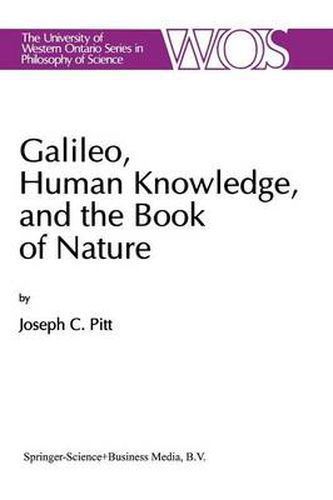Readings Newsletter
Become a Readings Member to make your shopping experience even easier.
Sign in or sign up for free!
You’re not far away from qualifying for FREE standard shipping within Australia
You’ve qualified for FREE standard shipping within Australia
The cart is loading…






This title is printed to order. This book may have been self-published. If so, we cannot guarantee the quality of the content. In the main most books will have gone through the editing process however some may not. We therefore suggest that you be aware of this before ordering this book. If in doubt check either the author or publisher’s details as we are unable to accept any returns unless they are faulty. Please contact us if you have any questions.
Galileo is revered as one of the founders of modern science primarily because of such discoveries as the law of falling bodies and the moons of Jupiter. In addition to his scientific achievements, Professor Pitt argues that Galileo deserves increased attention for his contributions to the methodology of the new science and that his method retains its value even today.
In a detailed analysis of Galileo’s mature works, Pitt reconstructs crucial features of Galileo’s epistemology. He shows how Galileo’s methodological insights grow out of an appreciation of the limits of human knowledge and he brings fresh insight to our concept of Galileo’s methodology and its implications for contemporary debates. Working from Galileo’s insistence on the contrast between the number of things that can be known and the limited abilities of human knowers, Pitt shows how Galileo’s common sense approach to rationality permits the development of a robust scientific method. At the same time, Pitt argues that we should correct our picture of Galileo, the culture hero. Instead of seeing him as a martyr to the cause of truth, Galileo is best understood as a man of his times who was responding to a variety of social pressures during a period of intellectual and political turmoil.
This book will be of interest to philosophers and to historians and sociologists of science as well as to a general readership interested in the scientific revolution.
$9.00 standard shipping within Australia
FREE standard shipping within Australia for orders over $100.00
Express & International shipping calculated at checkout
This title is printed to order. This book may have been self-published. If so, we cannot guarantee the quality of the content. In the main most books will have gone through the editing process however some may not. We therefore suggest that you be aware of this before ordering this book. If in doubt check either the author or publisher’s details as we are unable to accept any returns unless they are faulty. Please contact us if you have any questions.
Galileo is revered as one of the founders of modern science primarily because of such discoveries as the law of falling bodies and the moons of Jupiter. In addition to his scientific achievements, Professor Pitt argues that Galileo deserves increased attention for his contributions to the methodology of the new science and that his method retains its value even today.
In a detailed analysis of Galileo’s mature works, Pitt reconstructs crucial features of Galileo’s epistemology. He shows how Galileo’s methodological insights grow out of an appreciation of the limits of human knowledge and he brings fresh insight to our concept of Galileo’s methodology and its implications for contemporary debates. Working from Galileo’s insistence on the contrast between the number of things that can be known and the limited abilities of human knowers, Pitt shows how Galileo’s common sense approach to rationality permits the development of a robust scientific method. At the same time, Pitt argues that we should correct our picture of Galileo, the culture hero. Instead of seeing him as a martyr to the cause of truth, Galileo is best understood as a man of his times who was responding to a variety of social pressures during a period of intellectual and political turmoil.
This book will be of interest to philosophers and to historians and sociologists of science as well as to a general readership interested in the scientific revolution.